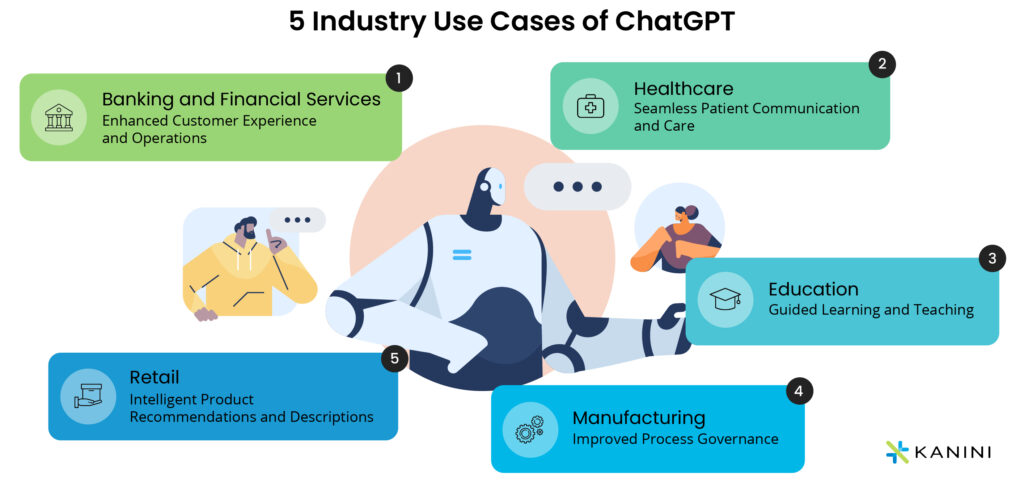1. Enhanced Customer Experience and Operations in Banking and Financial Services
One of the most noteworthy use cases of ChatGPT in the banking and financial services sector is the customer service department.
The model could be trained on frequently asked questions and customer inquiries, allowing it to assist in answering customer inquiries through a chat interface, potentially reducing the workload of human customer service representatives. The bot’s natural language understanding capabilities can be leveraged to help customers navigate banking websites and mobile banking apps more easily.
Moreover, areas like customer complaints management can run far more efficiently in terms of complaint handling quality and resolution time as the bot understands the context of a support ticket, finds contextually matching answers to the questions, and learns over time from the interactions saved in enterprise CRM.
2. Seamless Patient Communication and Care in Healthcare
Imagine ChatGPT being integrated into your healthcare app and as soon as you key in the symptoms, it recommends the top doctors for your ailment in your locality. To take it a step further, it even helps you book your appointment with that doctor. This is what we are talking about when we say that ChatGPT is going to be a game-changer.
In the healthcare industry, ChatGPT can assist in various areas of healthcare, such as remote consultation, medical diagnoses, clinical documentation, care coordination, and more. ChatGPT could be used to bridge the patient-provider gap —communicate effectively with patients, answer their queries, and provide information on their condition or treatment. This enhanced patient experience can be fundamental to building the value-based healthcare model that the industry is striving for.
In areas such as behavioral health services, for instance, ChatGPT can be very useful in creating crisp summaries of elaborate doctors’ notes and Q&A sessions. This meaningful gist of data can be processed more easily for diagnosis, prognosis, treatment, medical coding, billing, insurance, and other related processes.
With ChatGPT, healthcare can be made accessible to patients 24×7, enabling a practice to manage its patients more proactively, book appointments promptly, and easily overcome challenges like patient no-shows.
3. Guided Learning and Teaching in Education
Despite the downsides and concerns around using ChatGPT in education, ChatGPT is turning heads in the academic community. If we look at the positive side, ChatGPT can be a handy addition to the teaching toolkit for teachers and a significant research platform other than the standard search engines for students to explore and learn from.
This aside, in developing countries like India, ChatGPT can be instrumental in taking education to the rural and remote corners of the country where language is often a barrier to education. ChatGPT can act as a translator, translating important lessons in English or any other language to a language that the rural community members can understand. There can be many such applications of ChatGPT in education and these are being explored aggressively.
4. Improved Process Governance in Manufacturing
In the manufacturing segment, ChatGPT, when trained in a specific material or part of the manufacturing process, can function as a department’s virtual personal assistant. It could also simplify conversations and generate more meaningful interactions between the technical and non-technical workforce.
Its deep-learning capabilities can make it a good reference portal for workers who can refer to it to build their knowledge base and get answers to their queries.
ChatGPT can also work as a pre-trained process monitoring model to communicate the detected flaws efficiently, minimizing downtimes, and enhancing productivity and profitability.
5. Intelligent Product Recommendations and Descriptions in Retail
ChatGPT has been garnering a lot of attention from retailers ever since its launch. The AI bot can play a prime role in delivering a superior shopping experience for customers by gathering a better understanding of each customer persona.
Based on shopper segmentation data and shopping preference patterns, it can learn about the likes/dislikes of customers, their specific needs, expectations from a brand, and every other little detail.
The insights drawn from this data by ChatGPT can help the retailer to provide personalized shopping recommendations to its customers.
Additionally, ChatGPT can also leverage this data gathered from a customer’s past search histories, browsing behavior, and purchase records to create smarter, high-quality product descriptions that are optimized or more likely to match a customer’s search inputs. This can be significant for retailers striving to take customer satisfaction to the next level and increase their sales.










